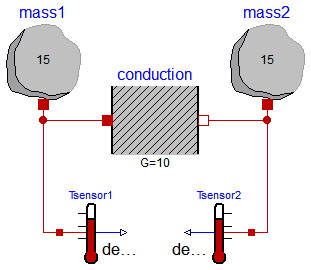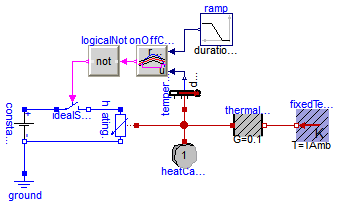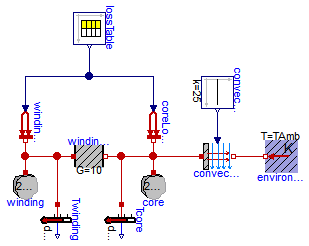Extends from Modelica.Icons.ExamplesPackage (Icon for packages containing runnable examples).
| Name | Description |
|---|---|
| Simple conduction demo | |
| Control temperature of a resistor | |
| Second order thermal model of a motor |
 Modelica.Thermal.HeatTransfer.Examples.TwoMasses
Modelica.Thermal.HeatTransfer.Examples.TwoMasses

This example demonstrates the thermal response of two masses connected by a conducting element. The two masses have the same heat capacity but different initial temperatures (T1=100 [degC], T2= 0 [degC]). The mass with the higher temperature will cool off while the mass with the lower temperature heats up. They will each asymptotically approach the calculated temperature T_final_K (T_final_degC) that results from dividing the total initial energy in the system by the sum of the heat capacities of each element.
Simulate for 5 s and plot the variables
mass1.T, mass2.T, T_final_K or
Tsensor1.T, Tsensor2.T, T_final_degC
Extends from Modelica.Icons.Example (Icon for runnable examples).
| Type | Name | Default | Description |
|---|---|---|---|
| Temperature | T_final_K | Projected final temperature [K] |
model TwoMasses "Simple conduction demo"
extends Modelica.Icons.Example;
parameter Modelica.SIunits.Temperature T_final_K(fixed=false)
"Projected final temperature";
HeatTransfer.Components.HeatCapacitor mass1(
C=15, T(start=373.15, fixed=true));
HeatTransfer.Components.HeatCapacitor mass2(
C=15, T(start=273.15, fixed=true));
HeatTransfer.Components.ThermalConductor conduction(
G=10);
HeatTransfer.Celsius.TemperatureSensor Tsensor1;
HeatTransfer.Celsius.TemperatureSensor Tsensor2;
equation
connect(mass1.port, conduction.port_a);
connect(conduction.port_b, mass2.port);
connect(mass1.port, Tsensor1.port);
connect(mass2.port, Tsensor2.port);
initial equation
T_final_K = (mass1.T*mass1.C + mass2.T*mass2.C)/(mass1.C + mass2.C);
end TwoMasses;
 Modelica.Thermal.HeatTransfer.Examples.ControlledTemperature
Modelica.Thermal.HeatTransfer.Examples.ControlledTemperature

A constant voltage of 10 V is applied to a temperature dependent resistor of 10*(1+(T-20C)/(235+20C)) Ohms, whose losses v**2/r are dissipated via a thermal conductance of 0.1 W/K to ambient temperature 20 degree C. The resistor is assumed to have a thermal capacity of 1 J/K, having ambient temparature at the beginning of the experiment. The temperature of this heating resistor is held by an OnOff-controller at reference temperature within a given bandwith +/- 1 K by switching on and off the voltage source. The reference temperature starts at 25 degree C and rises between t = 2 and 8 seconds linear to 50 degree C. An approppriate simulating time would be 10 seconds.
Extends from Modelica.Icons.Example (Icon for runnable examples).
| Type | Name | Default | Description |
|---|---|---|---|
| Temperature | TAmb | 293.15 | Ambient Temperature [K] |
| TemperatureDifference | TDif | 2 | Error in Temperature [K] |
model ControlledTemperature "Control temperature of a resistor"
extends Modelica.Icons.Example;
parameter Modelica.SIunits.Temperature TAmb(displayUnit="degC") = 293.15
"Ambient Temperature";
parameter Modelica.SIunits.TemperatureDifference TDif = 2
"Error in Temperature";
output Modelica.SIunits.Temperature TRes(displayUnit="degC") = heatingResistor.heatPort.T
"Resulting Temperature";
Modelica.Electrical.Analog.Basic.Ground ground;
Modelica.Electrical.Analog.Sources.ConstantVoltage constantVoltage(V=10);
HeatTransfer.Components.HeatCapacitor heatCapacitor(
C=1, T(start=TAmb, fixed=true));
Modelica.Electrical.Analog.Basic.HeatingResistor heatingResistor(
R_ref=10,
T_ref=from_degC(20),
alpha=1/(235 + 20));
HeatTransfer.Sources.FixedTemperature fixedTemperature(
T=TAmb);
HeatTransfer.Celsius.TemperatureSensor temperatureSensor;
HeatTransfer.Components.ThermalConductor thermalConductor(
G=0.1);
Modelica.Electrical.Analog.Ideal.IdealOpeningSwitch idealSwitch;
Modelica.Blocks.Sources.Ramp ramp(
height=25,
duration=6,
offset=25,
startTime=2);
Modelica.Blocks.Logical.OnOffController onOffController(bandwidth=TDif);
Modelica.Blocks.Logical.Not logicalNot;
equation
connect(constantVoltage.n, heatingResistor.n);
connect(constantVoltage.n, ground.p);
connect(heatingResistor.heatPort, thermalConductor.port_a);
connect(thermalConductor.port_b, fixedTemperature.port);
connect(heatingResistor.heatPort, temperatureSensor.port);
connect(heatingResistor.heatPort, heatCapacitor.port);
connect(constantVoltage.p, idealSwitch.p);
connect(idealSwitch.n, heatingResistor.p);
connect(ramp.y, onOffController.reference);
connect(temperatureSensor.T, onOffController.u);
connect(onOffController.y, logicalNot.u);
connect(logicalNot.y, idealSwitch.control);
end ControlledTemperature;
 Modelica.Thermal.HeatTransfer.Examples.Motor
Modelica.Thermal.HeatTransfer.Examples.Motor

This example contains a simple second order thermal model of a motor.
The periodic power losses are described by table "lossTable":
| time | winding losses | core losses |
| 0 | 100 | 500 |
| 360 | 100 | 500 |
| 360 | 1000 | 500 |
| 600 | 1000 | 500 |
The power dissipation to the environment is approximated by heat flow through
a thermal conductance between winding and core,
partially storage of the heat in the winding's heat capacity
as well as the core's heat capacity and finally by forced convection to the environment.
Since constant speed is assumed, the cinvective conductance keeps constant.
Using Modelica.Thermal.FluidHeatFlow it would be possible to model the coolant air flow, too
(instead of simple dissipation to a constant ambient's temperature).
Simulate for 7200 s; plot Twinding.T and Tcore.T.
Extends from Modelica.Icons.Example (Icon for runnable examples).
| Type | Name | Default | Description |
|---|---|---|---|
| Temperature | TAmb | 293.15 | Ambient temperature [K] |
model Motor "Second order thermal model of a motor"
extends Modelica.Icons.Example;
parameter Modelica.SIunits.Temperature TAmb(displayUnit="degC") = 293.15
"Ambient temperature";
Modelica.Blocks.Sources.CombiTimeTable lossTable(extrapolation=Modelica.
Blocks.Types.Extrapolation.Periodic, table=[0,100,500; 360,100,500;
360,1000,500; 600,1000,500]);
HeatTransfer.Sources.PrescribedHeatFlow windingLosses(
T_ref=from_degC(95), alpha=
3.03E-3);
HeatTransfer.Components.HeatCapacitor winding( C=2500, T(start=
TAmb, fixed=true));
HeatTransfer.Celsius.TemperatureSensor Twinding;
HeatTransfer.Components.ThermalConductor winding2core(
G=10);
HeatTransfer.Sources.PrescribedHeatFlow coreLosses;
HeatTransfer.Components.HeatCapacitor core( C=25000, T(start=
TAmb, fixed=true));
HeatTransfer.Celsius.TemperatureSensor Tcore;
Modelica.Blocks.Sources.Constant convectionConstant(k=25);
HeatTransfer.Components.Convection convection;
HeatTransfer.Sources.FixedTemperature environment(
T=TAmb);
equation
connect(windingLosses.port, winding.port);
connect(coreLosses.port, core.port);
connect(winding.port, winding2core.port_a);
connect(winding2core.port_b, core.port);
connect(winding.port, Twinding.port);
connect(core.port, Tcore.port);
connect(winding2core.port_b, convection.solid);
connect(convection.fluid, environment.port);
connect(convectionConstant.y, convection.Gc);
connect(lossTable.y[1], windingLosses.Q_flow);
connect(lossTable.y[2], coreLosses.Q_flow);
end Motor;